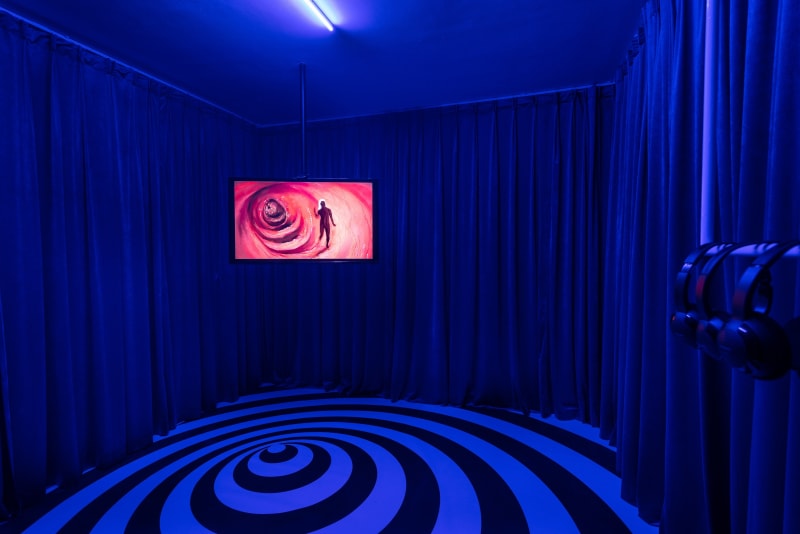In Wang Haiyang’s video work, Party in the Anus (2018), an ambiguously gendered figure gyrates and dances with reckless abandon in what appears to be the fleshy vortex of an anus. Echoing the anal spiral into nothingness, the dimly-lit room is carpeted in a whirling black-and-white optical illusion. Ensconced in a full-body suit that masks even their face, the figure appears to relish the debased, scatological environment, embracing what Leo Bersani might perceive as the body’s receptacle of death and disease. For Wang, partying in the anus at the end of the world is a productive proposition.
Biomorphic animacies are alive even in the walls of the space. Wang chose to coat the white-cube gallery in a deep electric blue. For Wang, this color is reminiscent of artist Derek Jarman’s cult film classic Blue (1993), in which a lurid shade of blue occupies, overwhelms, and even seems to jump out of the screen, reaching out to its spectators. Likewise, Wang is interested in chromatic agency. For him, color isn’t just medium or background. It is capable of contributing a life-giving energy of its own, shoring up the inhuman animacies of Wang’s hybrid creations.
The waning primacy of anthropocentrism can therefore be seen as a prime opportunity to locate other intimacies and vitalities. In an untitled series of watercolors, Wang represents what can only be thought of as semblances of spines, pincers, cells, clumps of hair, neurones, and disembodied eyes, enmeshed in an orgy of competing, inter-penetrating impulses. In some instances, figures appear to wear only a translucent skin through which spectators can see growth-like entities. These are not the organs or bodies we are familiar with, but rather bastardized accomplices in a web of interpersonal associations. Identifiable features like heads, eyes, mouths, and genitalia are barely discernible, suggesting a radical evasion of biopolitical surveillance.
Within this series, a particularly intriguing group of smaller watercolors departs entirely from any inkling of human figuration. While the majority of the series is rendered in flesh-tones, these watercolors sport more vivid, alien hues. Vaguely recalling ambivalent combinations of insects, flowers, and deep-sea fish, this cluster encapsulates what is most invigorating about Wang’s showing at Capsule: his comprehensive ontological overhaul of categorical knowledge. Naming and evaluating these watercolors by existing systems and vocabularies would indeed be antithetical to Wang’s artistic intent.
In the same vein, Neel Ahuja argues that neoliberal discourses, such as queer theory and environmentalism, are mired in an “ethical hygiene” that counterintuitively fortifies the taxonomical and ideological boundaries between human and non-human. Reinforcing tenets of political ecology, Ahuja suggests that, when faced with the threat of extinction, interspecies entanglement presents other life-worlds of possibility. Likewise, in Wang’s artworks, the erosion and mortality of the human form give rise to other versions of vibrant life and embodiment.



